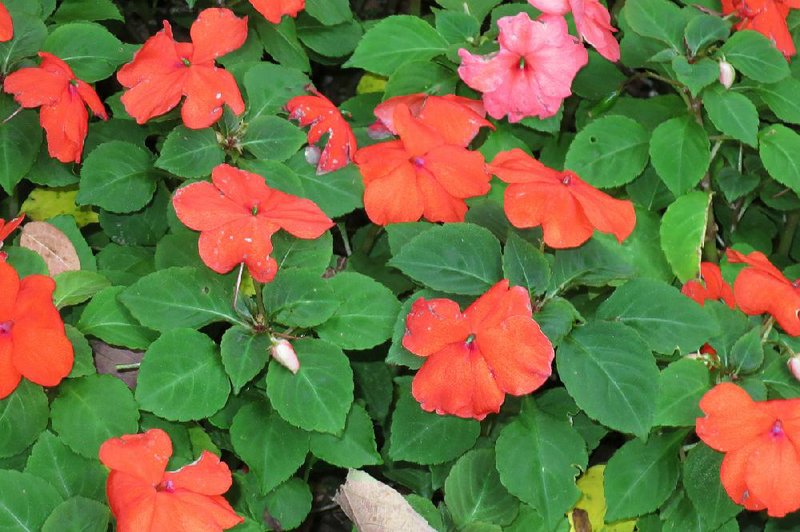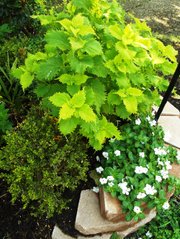We want color in our gardens, and flowering annuals are an easy and inexpensive way to achieve that color.
But the price goes up if the annuals we buy shrivel, die and have to be replaced as the heat picks up. After a cool spring, temperatures are rising and watering is becoming a bigger chore. Knowing which plants can take the heat will help keep the color blooming and your cost down.
When selecting annuals, your motto should always be “the right plant for the right spot.” (That should always be your motto, whether choosing annuals, shrubs or trees.) Choose the right plant for your location, and it will give you maximum performance.
Annuals, by definition, only live for one season. We have warm-season annuals and cool-season annuals, and some short-lived transitional annuals.
You don’t want to plant your entire garden in annuals or you would have to replace the garden every season. But you do want some annuals in strategic places in the garden where they can brighten things up.
Typically, annuals are less expensive than perennials or shrubs but you want the most bang for your buck, so choose annuals that will bloom all season, thriving in the heat that an Arkansas summer can dish out. Planting in a block of color at entrances or visible locations is key.
Keep in mind that they are only going to be in your garden for one season, so make the most of it by giving them the resources they need to do their best. Summer annuals need more fertilizer than any other plant you are growing.
Weekly applications, along with regular water, will keep them at peak performance.
Some plants are more tolerant of dry conditions than others, so group plants that need the same care.
HOW TO PICK THEM
The sea of choices at a garden center can be overwhelming. Do your homework and plan before shopping, so you can have success. Know your landscape:
How much sunlight it receives
The quality of your soil
Soil drainage and watering options
Then start picking plants.
Some annuals will do well in sun or shade, but most have a preference. If your yard receives full sun - at least six hours a day - you have a lot of choices.
Angelonia or summer snapdragon is an outstanding performer. This plant has a spike of flowers in pink, purple or white. It will bloom from frost to frost and is usually pest free. Not only can it take the heat, but it’s pretty drought tolerant once established.
Ageratum or floss flower is another full-sun option and one of those old-fashioned plants. The small, fuzzy flowers come in shades of purple and pink and will bloom all season with relatively little care.
Cosmos is a great summer annual that can be grown from seed or transplant. Find a sunny spot to sow some seeds, and the plants will grow quickly and give you blooms until frost. The feathery, ferny foliage is attractive and flowers come in a range of colors from whites to yellows, pink, red and orange. There are standard and dwarf forms available.
Lantana is a plant that is an annual in the northern tier of our state and a perennial in the southern half, but many people grow it as an annual. There are loads of new varieties with a wide range of mature size and color options.
Dwarf lantana can be a ground cover and run along the ground while the taller varieties sometimes reach 4 feet or more. Flower heads are made up of small flowers in shades of white, yellow, pink or red. Multicolored varieties come in yellow, orange, pink and white. Lantana is very drought tolerant once established.
Pentas or star flower is another excellent full-sun plant. The flower head is a cluster of small flowers. They come in pink, red, white and purple, with some bi-color blooms and a few varieties with variegated foliage. Butterflies and hummingbirds love this plant. They will give you nonstop color in full sun and are fairly drought tolerant.
Periwinkle or annual vinca is another heat lover. Glossy green foliage topped by pink, purple, white or red flowers, they take dry conditions well. They started losing popularity when people started installing sprinkler systems. They struggled with some diseases then, but new varieties are more tolerant and the plants are gaining ground again. Periwinkle flowers from frost to frost.
Zinnia is an old-fashioned plant that has had a face-lift in recent years. Common garden zinnias can be grown from seed and come in a range of colors, but occasionally can struggle with powdery mildew. Profusion and Zahara are two new varieties of zinnias that bloom nonstop, are disease free and thrive in hot weather. Flowers come in white, yellow, pink and orange.
MADE FOR SHADE
If you have shade, gardening can be a lot more enjoyable in the summer, and you have plenty of options for annuals.
The No. 1 shade-loving annual is still the common impatiens. Impatiens thrive in the shade, but they are not drought tolerant. They like moist conditions, but will pay you back with loads of color.
Common impatiens are the most shade tolerant of all the impatiens. Try some of the new varieties - SunPatiens, Fusion impatiens and New Guinea hybrids. They will not bloom in heavy shade but will do fine in light shade to light sun but keep the water nearby.
The begonia family is another sun-to-shade cross-over. The common wax-leaf begonia will grow in full sun to total shade. Flowers come in red, pink or white, with single or double varieties.
Dragon wing begonia is a cross between the wax-leaf and angel wing begonia. A much larger plant at maturity, it comes with pink or red flowers. Plant it in light shade or full morning sun and afternoon shade. Rex or hybrid begonias give you even more options. They have beautifully colored foliage in a wide array of patterns. These do best in a shady location or with only filtered sunlight. Begonias need a well drained soil as they are not tolerant of wet feet.
Torenia or wishbone flower is a great annual for light to deep shade. Flowers come in purple, pink, white or yellow and bi-colors are also available. It is commonly called wishbone flower because the two stamens merge to form a wishbone shape in the center of the flower.
Coleus plants are not grown for the small flowers they can produce but for their colorful foliage. There are varieties that do well in full sun or total shade. Foliage size and colors vary tremendously, with new varieties released every year. From the bright chartreuse “Wasabi,” which thrives in full sun, to the shade-loving orange “Sedona,” there is a coleus for every situation. They like a little water and love heat but are gone with the first hint of frost.
Other plants grown for foliage include:
Polka dot plant (Hypoestes). The leaves are speckled with red, pink or white dots, giving the plant its common name. Plant height ranges from 9 to 18 inches.
Alternanthera or Joseph’s coat can go from full sun to shade, but thrives with a little late afternoon shade. Varieties can be dwarf or standard and come in a wide range of color.
Iresine, commonly called gizzard plant or bloodleaf, is good for sun or shade and is grown for its colorful leaves.
Ornamental sweet potato vine will thrive no matter how hot it gets. Foliage can be lime green to dark purple, but give them room to grow, because they are vigorous.
And don’t forget the caladium. Caladiums are summer annual bulbs. They thrive in shady locations in a variety of foliage colors in shades of white, pink and red. The bulbs will not overwinter, but can be dug and replanted each year.
TRY SOMETHING NEW
New annuals appear every year in our market, so experiment. You can use houseplants or summer tropical plants for seasonal color and move them back inside in the fall.
Regardless of what you are g rowing, know the plant’s needs. Even the most drought-tolerant plant needed a little water last summer, and who knows what is in store for us this year? Mulch will help keep moisture in.
Annuals like fertilizer, but be careful when fertilizing. If your plant is overly dry, you could burn the plant. Always err on the side of too little fertilizer versus too much.
If the stems get leggy, pinch them back to encourage fullness. Some annual varieties are called “self-cleaning,” which means they don’t set seeds but continually bloom. If you have an older variety that sets seeds, you will need to clip off the spent blooms periodically - a process called dead-heading. If you allow each flower to set seeds, too much energy is going into seed production when what you want is flowers.
If your plants become disease ridden or infested with bugs, toss them and plant something else. Don’t go to extreme measures to save a plant that is only in the garden one season. Luckily for us, annuals are available year-round at garden centers. While you don’t have the wide selection of annuals in midsummer that you would in the spring or fall, you do have choices.
As long as you can provide water, you can plant and have success.
HomeStyle, Pages 33 on 06/15/2013


